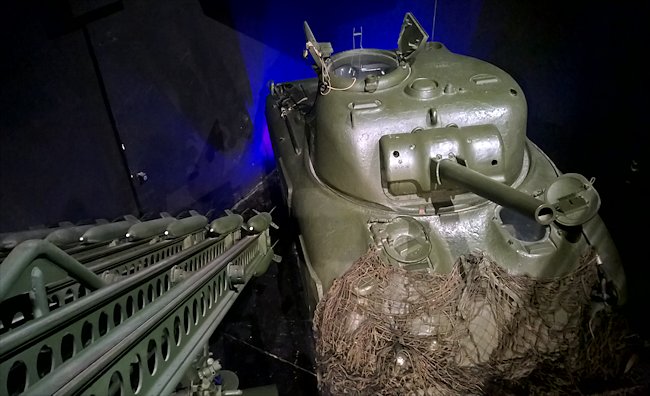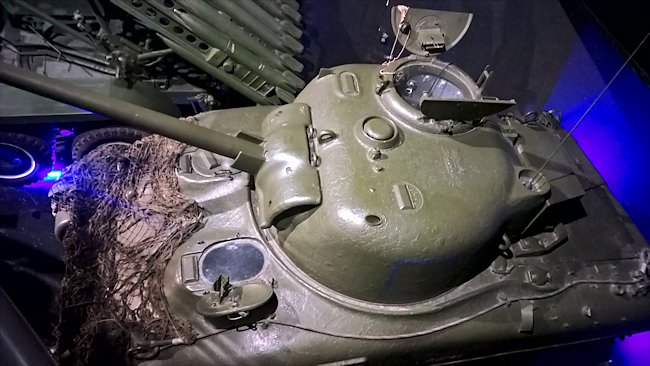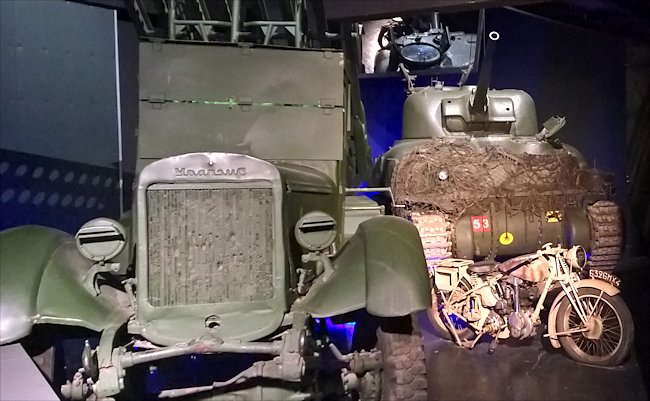M4A1(75) Sherman Grizzly Tank at the Caen War Memorial
The Caen War Memorial is huge. It is also has the most expensive D-Day War museum entrance ticket in Normandy. It is double the cost of the other local museum's. It is a history of the Second World War museum not a Military Museum with lots of equipment on display or just a D-Day Museum.

The M4A1 Sherman Grizzly tank was built in Canada
Location
The Memorial De Caen can be found on the Avenue du Marechal Montgomery at the junction with the Rue des Roquemonts. Do not enter the Rue des Roquemonts road into your Sat-Nav. It is a long road and it will probably direct you to the other end where you will start to think you have come to the wrong place as it is in a business district.
Specification
The M4A1 Sherman Grizzly tank was manufactured in Canada by the Montreal Locomotive Works MLW from 1943 to 1944. It was based on the US M4 Sherman tank with a few modifications. It had thicker more sloping armour and was fitted with Canadian Dry Pin (CDP) tracks that did not require rubber. This was important as it was hard to locate good supplies of rubber during war time. It also had 17 teeth on the drive sprocket wheel compared with American built tanks that only had 13 teeth on their drive sprocket track wheels.
The Grizzly Sherman Tank was fitted with a 75mm M3 L/40 gun and two machine guns. One machine gun was fitted in the hull and the other next to the main gun in the turret. The tank was powered by a Continental R-975 9-cylinder radial petrol engine that produced 400 bhp. It had a maximum road speed of 24 mph (38.6 km/h). The M4A1 Grizzly Sherman had an operational range of around 193 km. It needed a five man crew: Commander, gunner, loader, driver, co-driver/hull machine gunner.
Only 188 were built. many were sold to Portugal after WW2 and retired from the Portuguise Army in the 1980's. They were sold by auction and picked up by Military Vehicle Tank enthusiasts and museums.

The M4A1 Grizzly had a cast hull and turret
The Caen War Museum and Memorial
The Memorial de Caen covers the origins of the Second World War, the effect on civilians as well as soldiers, the development of the war around the globe, the horrors of war, the French resistance and the Allies invasion.
Compared with other museums in Normandy it has a surprising lack of artifacts on display. There is an impressive rocket firing ground attack RAF Typhon in the entrance hall but there is only one tank and that is a M4A1 Sherman Grizzly Tank displayed next to a Russian Katuska Rocket launcher.

The tank's Standard 75mm gun could not penetrate the front armour of a German Tiger tank. It is exhibited next to a Russian Katuska Rocket launcher
There is free car parking, a cafe and a shop that sells lots of military history books, models, replica kit, T shirts, baseball hats and other related souvenirs. It will take you a couple of hours to walk around the museum, read all the information and watch all the short films. The display boards are in English and French. You can use Audio guides, which you collect at the entrance desk, to give you additional information.
The development of the Grizzly Sherman Tank
The Grizzly Sherman Tank was the basic M4A1 medium tank design built in Canada by Montreal Locomotive Works after completion of the Ram II and Ram OP/Command contracts. It differed from the M4A1 principally by being fitted with Canadian CDP tracks (though M4 tracks could also be used) and by the installation of British pattern wireless equipment as built.
A prominent stowage box was added on the turret, and sand-shields were fitted as standard. Another feature introduced in the Grizzly was a 2in smoke mortar in the turret roof to meet British/Canadian requirements. This was, as a result of experience with the Grizzly, subsequently fitted in all American-built M4 series tanks.
Plans to produce the M4A1 in Canada had been made as early as September 1942. However, the limited facilities of Montreal Locomotive Works meant that production could not start for another year. Between September-December 1943, a total of 188 Canadian-built M4A1s was produced, the name Grizzly I being given to this vehicle by the Canadians.
M4A1 production in Canada was prematurely cut short by the decision to concentrate all M4 series production in American plants, which in 1944 had sufficient free production capacity to meet all M4 series tank requirements for Allied armies. The Grizzly, together with US-built M4s, equipped Canadian armoured battalions in Canada and Europe.
Panzer Divisions in Normandy
'The effect of the major conflicts in the west and the east was reciprocal,' stated German Commander Jodl, when he was interrogated with Keitel at the end of the war. 'Each of the fronts felt itself neglected compared to the other.' The concentration of SS panzer divisions in Normandy, especially the transfer of the II SS Panzer Corps back from the eastern front, had highlighted their inability to respond effectively to the Soviet Operation Bagration. 'The two-front war came into sight in all its rigour,' Jodl observed.
A liaison officer from the Red Army, Colonel Vassilievsky, was brought on a visit to the headquarters of British 7th Armoured Division. With true Soviet diplomacy, he expressed the view that the British advance was very slow. Apparently a British officer asked him to show on a map of the eastern front where his own division was fighting. It transpired that there were nine German divisions on that sector, which was over 600 miles long. The British pointed out that they were facing ten divisions, including six panzer divisions, along a front of only sixty-two miles.
Normandy Bocage hedgrow danger
They Allies received a bloody introduction to Boacage hedgerow fighting when twelve Shermans were knocked out almost as soon as they emerged through a gap in a hedgerow. Another problem was that American 75mm tank ammunition, besides having less penetrative power compared to the German shells, also gave off much more smoke than the German, which put them at a severe disadvantage in hedgerow fighting.
Where else can I see preserved Canadian built Sherman Grizzly Tanks?
- M4A1(75) - Tank Museum, Bovington, Dorset, England
- M4A1(75) - Imperial War Museum, Duxford, England
- M4A1(75) - D-Day Museum, Portsmouth, England
- M4A1(75) - Muckleburgh Collection, Norfolk, England
- M4A1(75) - Light Dragoons Garrison, Catterick, England
- M4A1(75) - Bevrijdingsmuseum, Groesbeek, Netherlands
- M4A1(75) - Private collection, Mons, Belgium
- M4A1(75) - Private collection, Turnhout, Belgium
- M4A1(75) - Private collection, Luxembourg
- M4A1(75) - Caen Memorial, Caen, France
- M4A1(75) - 2x Christian Dours Collection, Chartres, France
- M4A1(75) - Jeepest Collection, Chateaudun , France
- M4A1(75) - Private Collection, Italy
- M4A1(75) - Colégio Militar, Lisbon, Portugal
- M4A1(75) - Former military barracks, Elvas, Portugal
- M4A1(75) - CMSM Santa Margarida da Coutada, Portugal
- M4A1(75) - Regimento de Manutenco, Entroncamento, Portugal
- M4A1(75) - Polish Army Museum in Warsaw, Poland
- M4A1(75) - National Armor and Cavalry Mus, Fort Benning, GA, USA
- M4A1(75) - Private collection, Tifton, GA, USA
- M4A1(75) - Don. F. Pratt museum, Fort Campbell, KY, USA
- M4A1(75) - Larry Mogge Collection, KS, USA
- M4A1(75) - Private collection, Mount Angel, OR, USA
- M4A1(75) - The Collings Foundation, Stow, MA, USA
- M4A1(75) - Private collection, CA, USA
- M4A1(75) - Veluzat Motion Picture Ranch, CA, USA
- M4A1(75) - Canadian War Museum, Ottawa, Canada
- M4A1(75) - 2x Canadian Forces Base, Borden, Canada
- M4A1(75) - Canadian Forces Base, Shilo, Canada
- M4A1(75) - National Army Museum, Waiouru, New Zealand
- M4A1 Firefly 17pdr - Canadian Forces Base, Borden, Canada
D-Day 1944 books

